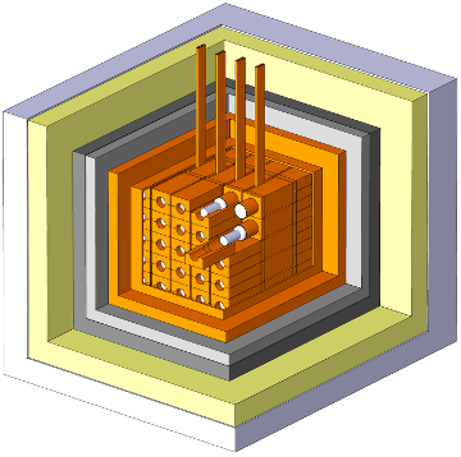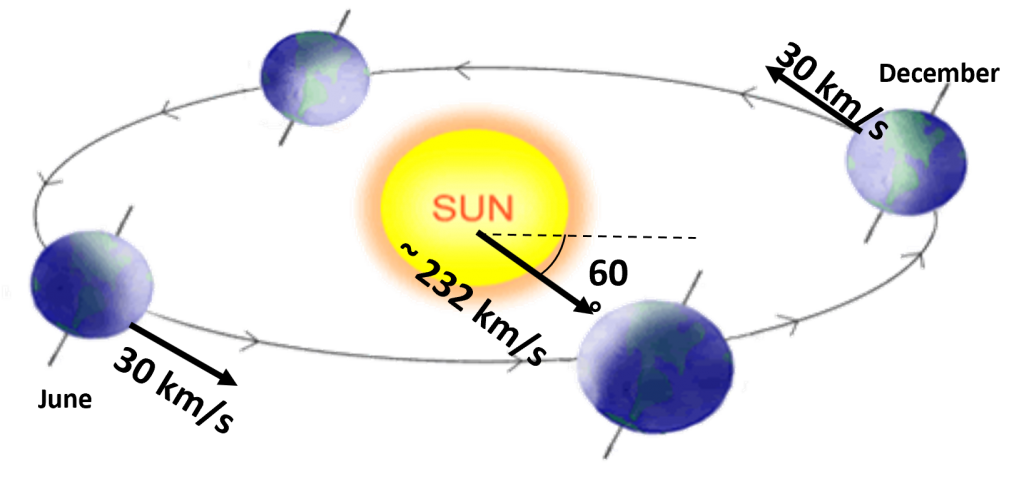DAMA/LIBRA (Large sodium Iodide Bulk for RAre processes) experiment is the 2nd generation NaI(Tl) experiment of DAMA project. Together with the former DAMA/NaI set-up, DAMA/LIBRA has been designed and built to exploit the model independent annual modulation signature and to point out the presence of Dark Matter particles in the galactic halo independently on hypothesized theoretical models.
The apparatus
The set-up is composed by 25 highly radiopure NaI(Tl) crystal scintillators (5-rows by 5-columns matrix) having 9.70 kg mass each one. In each detector two 10 cm long
UV light guides (made of Suprasil B quartz) act also as optical windows on the two end faces of the crystal, and are coupled to two low background photomultipliers (PMTs)
working in coincidence at single photoelectron level. The detectors are placed in a
sealed low-radioactive copper box installed in the center of a low-radioactive Cu/Pb/Cd-foils/polyethylene/paraffin multi-ton shield; moreover, about 1 m concrete (made from the Gran Sasso rock material) almost fully surrounds (mostly outside the barrack) this passive shield, acting as a further neutron moderator. A threefold-levels sealing system prevents the detectors to be in contact with the environmental air of the underground laboratory maintaining the detectors in HP-Nitrogen atmosphere.

The Dark Matter annual modulation signature
The Dark Matter annual is signature, originally suggested in the mid ‘80s by Freese et al., requires that many specific peculiarities are simultaneously satisfied in order to provide unequivocal evidence. In fact, as a consequence of its annual revolution around the Sun, which is moving in the Galaxy, the Earth should be crossed by a larger flux of Dark Matter particles around 2 June (when the Earth orbital velocity is summed to the Sun velocity in the Galaxy) and by a smaller one around 2 December (when the two velocities are opposite). Thus, this signature has a different origin and peculiarities than the seasons on the Earth and than effects correlated with seasons (consider the expected value of the phase as well as the other requirements listed below). The DM annual modulation signature is very distinctive since the effect induced by DM particles must simultaneously satisfy all the following requirements: the rate must contain a component modulated according to a cosine function (1) with one year period (2) and a phase that peaks roughly around about 2nd June (3); this modulation must only be found in a well-defined low energy range, where DM particle induced events can be present (4); it must apply only to those events in which just one detector of many actually “fires” (single-hit events), since the DM particle multi-interaction probability is negligible (5); the modulation amplitude in the region of maximal sensitivity must be < 7% for usually adopted halo distributions (6), but it can be larger in case of some possible scenarios. This approach is very competitive and it needs the realization of an experiment with large mass, high radio-purity and high control of the running conditions.
The results
DAMA/LIBRA has measured an annual modulation effect satisfying all the peculiarities of the considered signature. The data collected in the first phase of DAMA/LIBRA (DAMA/LIBRA-phase1) confirmed the model independent evidence for the presence of Dark Matter particle in the galactic halo pointed out by DAMA/NaI. The cumulative exposure collected, considering the 7 annual cycles of DAMA/NaI and the 7 annual cycles of DAMA/LIBRA-phase1, was 1.33 ton x year. The model independent evidence is observed with a statistical significance of 9.3σ C.L..
At the end of 2010 the experiment was upgraded and the new measurements started on January 2011, DAMA/LIBRA-phase2. All the photomultipliers were replaced by PMTs Hamamatsu R6233MOD, with higher quantum efficiency (Q.E.) and with lower background with respect to those used in phase1; they were produced after a dedicated R&D, tests and selections with the company. The commissioning of the experiment was successfully performed in 2011, allowing the achievement of the software energy threshold at 1 keV and the improvement of some detector’s features such as energy resolution and acceptance efficiency near software energy threshold. In 2021 an effort to analyse the data down to 0.75 keV have been performed.
The first results of DAMA/LIBRA-phase2 were released in 2018 considering the data collected over 6 annual cycles and further 2 annual cycles have been released in 2021 (total exposure of 1.53 t x yr). The DAMA/LIBRA-phase2 data confirmed the evidence of a signal that meets all the requirements of the model independent Dark Matter (DM) annual modulation signature. In the energy region between 2 and 6 keV, where data are also available from DAMA/NaI and DAMA/LIBRA-phase1, the achieved C.L. for the full exposure (2.86 t x yr) is 13.7σ.

This model independent result is compatible with various Dark Matter candidate particles, interaction types and scenarios. No experiment whose results can be directly compared in a model independent way with these ones is available in the field.

The unique properties and characteristics of DAMA/LIBRA will also allow in the future the further investigation of the features of the candidate particles and of the astrophysical, nuclear and elementary particle aspects related to the signal characteristics and of the possible second order effects. The DAMA/LIBRA set-up has also obtained several other results on other approaches and on various rare processes. The experiment has been upgraded and at present DAMA/LIBRA-phase2 is running. At present (October-November 2021) new pre-amplifiers and HV divider system, and new Transient Digitizers have been installed.

